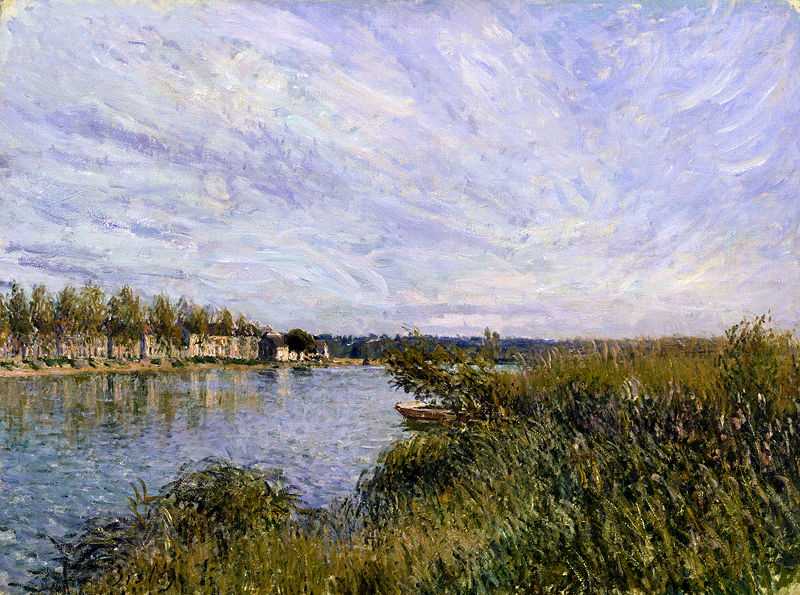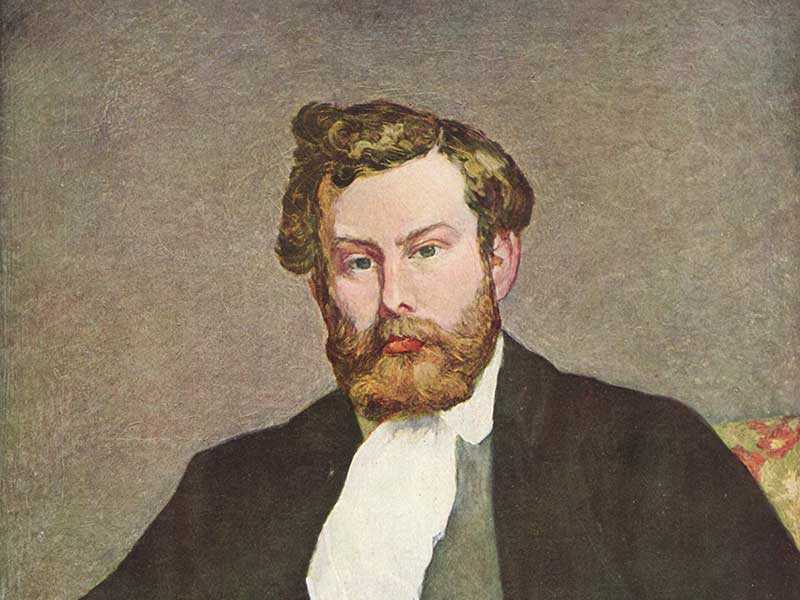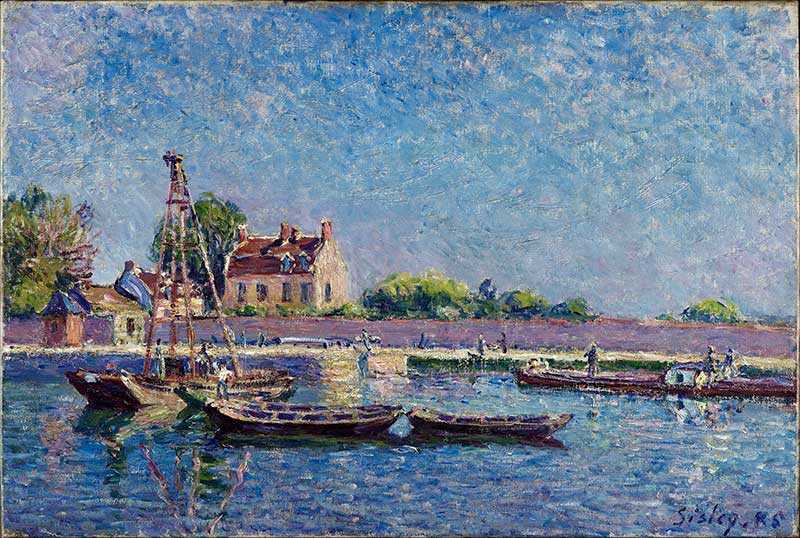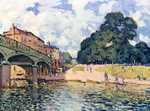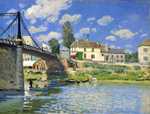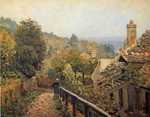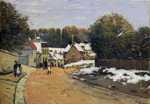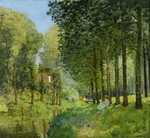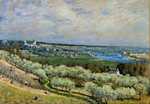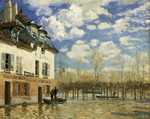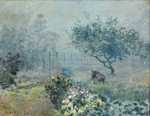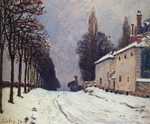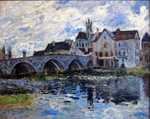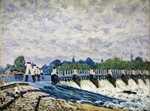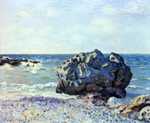1. Sisley’s early years
Sisley’s family ties and childhood years are partially responsible for making him a contentious figure in French art.
Born in Paris in 1839 to English parents and a French grandmother, Sisley spent his early life in France. His father, William Sisley, was a tradesman who owned a successful business importing and exporting luxury goods. In his adolescence, he went to London to study commerce and improve his English.
Sisley the Student
It was during his studies in London that Sisley was able to visit the National Gallery and study the works of John Constable and J.M.W. Turner. Whilst pursuing four years of education at his father’s request, Sisley began painting as an amateur.
These earliest influences had a profound impact on Sisley's style and desire to pursue landscape painting, following some of the greatest figures of that genre.
Interesting fact...
Sisley quickly turned from business to art and his life took a new course. From 1862 he trained in Paris alongside many of the key figures of the Impressionist movement. His art studies took place under the Swiss painter Charles Gleyre and his colleagues in the studio included Claude Monet, Pierre-Auguste Renoir and Frederic Bazille.
Gleyre had been a student of Jean-Auguste-Dominque Ingres, a neoclassical painter. Like his colleagues, Sisley rejected this restrictive neoclassical style and wished to paint art that was closer to life, without religious or mythical symbolism, in a manner much closer to the realist school let by Camille Corot.
Their shared desire for a break and a disruption of French art traditions brought the group closer and they become firm friends.
The Impressionist Foursome
This foursome - Sisley, Renoir, Monet and Bazille- began to experiment with painting ‘en plein air’ rather than in the studio. They went to the the village of Chailly in the Forest of Fontainebleau, a favourite destination for the Barbizon School of painters before them, and attempted to make their artistic vision into a reality.
This was really the beginning of Impressionism and the development of a new aesthetic. These artists championed the presentation of ordinary life and chose to focus on light and range of colours.
Love and War
In 1866, Sisley began a relationship with Eugenie Lesouezec, known as Marie. Around the beginning of their affair, his mother, Felicia, died. On a brighter note, Sisley and Eugenie soon had two children: a son in 1867 and a daughter in 1869.
Though Sisley’s family were affluent, the Franco-Prussian war of 1870-71 disrupted William’s business and drove the family into financial ruin. He died shortly after. Sisley fled to London to escape the war, just like Monet and Camille Pissarro, and it was during this time that he embarked upon a full-time career as a painter.
Interesting fact...
Recent letters suggest that Sisley's father may have cut off his allowance even before the Franco-Prussian War, because he disapproved of Sisley's relationship with Eugenie.
Most of his works from before this period, when he was an art student, have now been lost. His house on the outskirts of Paris was occupied by Prussian troops during the war and ransacked.
2. Sisley’s Île-de-France paintings
Without his father's allowance, Sisley would have had to support his young family with no reliable earnings from his chosen career.
In the face of this considerable challenge, Sisley threw himself into painting full time. It is this period of intense productivity that gave rise to some of his most impressive works.
Return to France
After returning to France following the concllusion of the Franco-Prussian war, Sisley became interested in the suburbs of Paris as an alternative to his focus on rural scenes. One key piece from this period depicts a flood at the port in Marly after the Seine burst its banks, painted in 1872.
A partially submerged cafe is pictured and its reflection, the water and the sky merge together in dappled greys, blues and brown tones. Sisley used a wide spectrum of hues to create the effect, building up the colours with thin layers of graceful brushstrokes.
A similar composition is seen in the earlier work, ‘View of the Canal Saint-Martin’ from 1870, which was exhibited at the Paris Salon the same year. This palette is characteristic of his works immediately following the war.
Sisley's Golden Period
The 1870s are widely considered to be the most productive and arguably most impressive period of Sisley’s career. His depictions of the Parisian suburbs, including Meudon and Louveciennes, are animated and expressive. It was during this period that he was also in close contact with Claude Monet and the artists encouraged each others stylistic development.
Later, his paintings become freer. His works from the 1880s are some of his most colourful, exhibiting a range of hues that combine to create a sense of realism and life in his landscapes. Sisley excelled at capturing a moment in time, bringing to his canvases the sense of movement and change that is everywhere in the natural world. The way in which he used natural light and experimented with perspective allowed Sisley to transport viewers into his scenes.
His process mimicked this fleeting style also. Sisley only worked outside and never retouched or added to his works once they were back in the studio, taking ‘en plain air’ to its extremes. The way he created his art was as transient and emotional as the scenes themselves.
Sisley and Monet
Monet's enduring influence on Sisley’s works is evident in paintings such as 'Haystacks at Moret, Morning’ from 1891. Of course, Monet also painted a series of Haystack works but there are other visual cues that show a crossover between the artists’ works.
Notably, the use of poplars in the background but also the colour palette of sensual oranges and reds, layered in thick paints and small, loose brushstrokes that Sisley used. Critics have also cited similarities between Sisley’s haystacks and Pissarro’s depictions of harvests and hay ricks from the 1870s.
3. Sisley and the Barbizon School
Sisley’s work was heavily influenced by earlier periods of French and English painting and he borrowed from the Barbizon School in particular.
In turn, the Barbizon school had been inspired by the work of John Constable, a 19th century English painter.
Constable's influence
One of Britain’s most famous landscape artists, Constable specialised in painting landscapes with a naturalism that was unrivalled at the time in British art. He played with colour and light to present his landscapes in a romantic but realist style.
His painting technique was highly unconventional for the era as he varied between using a knife to layer thick paint on the canvas and at other times, using the finest of brushes to apply small flicks of colour. This experimentation meant that he was largely rejected by the British art establishment during his life but he found praise among Parisian artists.
The Barbizon School
His most important protégés in France were the painters of the Barbizon School. After seeing his works, they were inspired to leave Paris and explore the rural landscape beyond, painting ordinary subjects and natural scenes with the same level of realism and romance that Constable had achieved.
This group included artists such as Camille Corot and Théodore Rousseau. In doing so, they broke away from French Neo-classical landscape painting.
The Barbizons and impressionism
Sisley’s own inspiration from the Barbizon School is one example of the movement’s direct influence on Impressionism. However, most other Impressionists employed wider colour palettes in their works. In contrast, Sisley stayed faithful to the Barbizon School’s sensitivity towards natural subjects, favouring natural hues, as well as their tendency to stray into romanticism. Sisley’s works are both emotional and realistic at the same time.
Influences from Camille Corot can also be seen in Sisley's delicate colour palette and use of silvery tones. This is evident in the beautifully dreamy work ‘Fog, Voisins’ from 1874 where the viewer glimpses a woman in a garden and can just make out a line of trees, a fence and tufts of grass in the background.
4. Sisley’s Impressionism
It is ironic that Sisley’s works should have been so undervalued during his lifetime: in many ways he is the paradigm of the impressionist painter.
From his focus on light to his feathery brushstrokes, Sisley captured the impressionist movement in his landscape paintings. Similarly, he exhibited at the first Impressionist exhibition in 1874 and worked with the foremost impressionist dealer, Paul Durand-Ruel.
Sisley's anonymity
Very little is known about Sisley’s personal life as he left behind few documents and just a single sketchbook of his work. We know nothing of his rages, womanising or fits of artistic passion as we do we other artists from this period. He remains a hidden and largely anonymous character.
In spite of this collective amnesia on the part of the art world, it is important to stress that Sisley was as revolutionary as the other impressionists. He was one of the first to champion depictions of ‘modern life’, albeit from the countryside. Similarly, his loose, rough style that had the air of a sketch rather than the precise detail of earlier Neo-classical and Romantic works is also very important for the development of art from this point onwards.
At the same time, Sisley’s work also demonstrates the influence of neo-classicism in the way in which he applied paints to his canvas. The precise spots of colour in ‘The River Loing at Saint-Mammès’ from 1885 is one such example. This painting uses whites, reds, purples and blues to compose the sky and the reflections in the water, giving the colours greater vibrancy.
This use of colour theory borrows directly from the pointillists including Georges Seurat and Paul Signac.
Sisley's snow scenes
Sisley’s snow scenes are considered to be some of his most impressive works, featuring layer upon layer of white, silver and grey hues, built up to form the winter terrain. He excelled at creating a sense of sadness in his landscapes and winter suited his style well, providing an opportunity for him to study the variations in light that were so central to the Impressionist style.
At the same time, he was able to capture the colours of the scene in his characteristically nuanced style. ‘La neige à Louveciennes’ or ‘Snow at Louveciennes’ from 1878 is one example of his snowy landscapes, demonstrating his use of perspective and large range colour shades. Spending winters in the Parisian suburbs allowed him to paint a number of studies of snow. These works are archetypal examples of the Impressionist interest in natural light.
5. Sisley’s later works & legacy
Due to his failing health, Sisley’s later works do now show the same development as many of the other Impressionists.
Suffering from throat cancer, he was confined to England and was not able to travel to France. As a result, Sisley’s work remained faithful to a more traditional style of impressionism.
Seascapes
His paintings of the Welsh coast from this time stand out among his other works. This is in part because they are his only seascapes but also because the soft, glowing light and gentle brushstrokes in these paintings embody the Impressionist style that eventually made the movement so popular. His application of colour is freer and more emotional than his earlier works, creating a hazier impression of the coastline.
Commercial success ... eventuallly
For much of his life, Sisley and his family lived in poverty. He was unable to sell many of his paintings and his talent went largely unknown. This can be seen in his cycle of moving his family year on year, between better and worse accommodations. They changed location roughly every other year, according to how much he earnt from the sale of each painting.
It was only after his death in 1899 that Sisley became recognised for his innovative style and his paintings became a commercial success, rising in price dramatically. Shortly before he died, Sisley invited Monet to his house. It was during this visit that he asked his good friend to look after his children when he died.
Later that year, Monet encouraged Georges Petit to hold an auction of Sisley’s works to raise funds for Sisley’s children. Most painfully, it was at this auction, just a year after his death, that Sisley’s painting ‘Flood at Port Marly’ sold for 43,000 francs. It was recognised by Count Isaac de Camondowho purchased the work and generated new found interest in Sisley’s art.
Sisley had sold 27 works before he died for little over twice the amount paid for this one painting.
Sisley’s legacy
Despite his English parents, Sisley was firmly French in all but citizenship. He lived for most of his life in France, married a Breton woman and had two children in France. He applied for citizenship but it was not granted before his death. His work reflects his focus on French landscapes and the areas around Paris, which he painted with delicacy and a sense of fleeting moments in time.
Though he pioneered in developing the Impressionist style, Sisley’s influence on the movement has largely been forgotten. This has largely been attributed to his position as an outlier in the eyes of French art historians due to his time spent in England and his British heritage. However, his artworks speak for themselves in their expressive style.
Sisley was the Impressionist who bridged English and French artistic traditions, developing them into something that was entirely his own. He took his inspiration from the Barbizon School, Corot and Constable, and in turn helped to inspire a new generation of painters. The most widely recognised among them was Paul Cezanne, whose use of light and colour builds on Sisley’s works.
Today, Sisley’s paintings are sold for millions of pounds, sharply contrasting with the financial struggles that stayed with him throughout his life. However, he can still be seen as one of the underdogs of the Impressionist era and an often forgotten founder of the movement. Sisley remains an intriguingly unknown figure, as fleeting and intangible as the clouds in the skies above his landscapes.
Learn more on our page about Sisley's Best 10 Paintings.
Sisley resources
To take your knowledge to the next level, check out our resources page - you'll find recommendations on the best impressionist books, videos and gifts.

